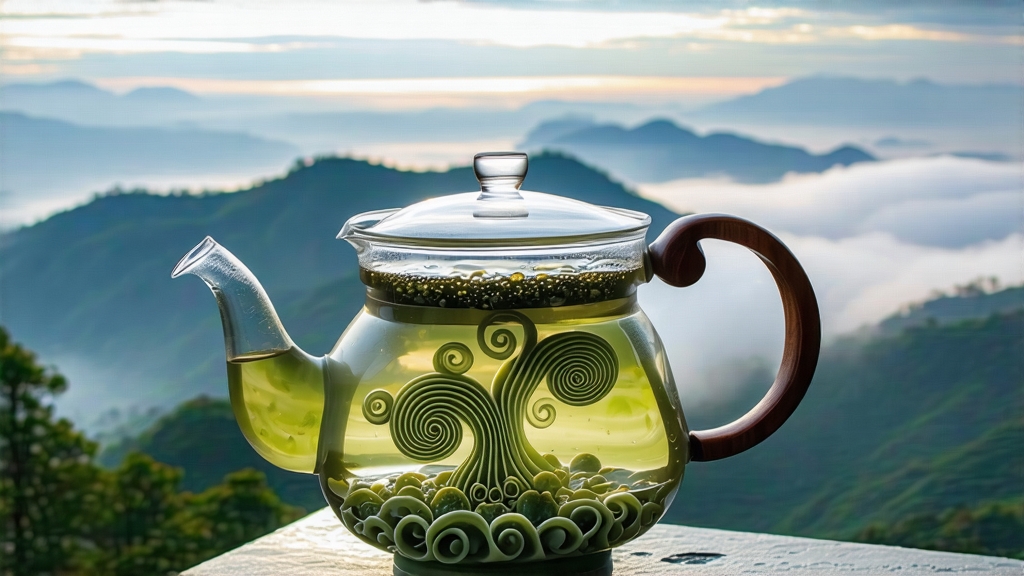
Tucked between the mist-laden peaks of Dongting Mountain in Jiangsu Province and the vast, fish-rich Taihu Lake lies the birthplace of one of China’s most delicate green teas—Biluochun. Its name, literally “Green Snail Spring,” is a poetic compression of three truths: the jade color of the finished leaf, the tight spiral shape that resembles a tiny snail shell, and the early-spring harvest window that grants the tea its legendary softness. To international drinkers who know only the broad label “Chinese green tea,” Biluochun is a revelation: a liquor so fragrant that locals claim the leaves can scent an entire room before water ever touches them, and a sweetness so persistent that even the seventh infusion still whispers of apricot blossom and fresh peas.
Historical records first mention the tea during the late Tang dynasty (618-907), but its apotheosis arrived in the Kangxi reign (1661-1722) of the Qing. The emperor, touring the lower Yangtze region, was offered an infusion whose aroma he likened to “morning dew on wild orchids.” Finding the original name “Xia Sha Ren Xiang” (literally “astoundingly fragrant”) too rustic for imperial taste, he penned the elegant two-character replacement “Biluochun” on the spot. From that moment the tea joined Longjing, Huangshan Maofeng, and Liu’an Guapian on the roster of tribute teas, carted northward each spring in bamboo-lined chests sealed with yellow silk.
Botanically, Biluochun is almost exclusively produced from a Jiangsu-specific cultivar called Fuding Xiao Ye Zhong, a small-leaf varietal that has adapted to the lake’s micro-climate. The bushes sit on terraces between 150 m and 300 m above sea level; the water body moderates temperature, while morning fog filters sunlight into a soft, diffused glow. These conditions force the plant to synthesize more theanine and aromatic volatiles, gifting the tea its hallmark umami broth and floral nose. Growers further refine leaf chemistry by interplanting the bushes with fruit trees—peach, plum, and apricot—so that falling petals and shared pollinators imprint subtle honey-floral notes on the nascent buds.
The picking calendar is ruthless: only the bud and the immediate adjacent leaf, plucked before the Qingming festival (around April 4th), qualify for the top grade “Special One.” A skilled picker can gather just 600 g of fresh leaf in a day; 5.5 kg of this fluff-light material shrink to 1 kg of finished tea after the intricate nine-step craft. The process begins with withering on bamboo trays for two hours, just long enough to reduce surface moisture without oxidizing the greens. Next comes the only mechanized stage: a 3-minute tumble in a 90 °C rotating drum that “kills the green” (shaqing), locking in chlorophyll and arresting enzymatic browning. Master craftsmen then transfer the hot leaf to woks kept at an almost skin-burning 180 °C, flicking and pressing the tea with bare hands in motions that resemble a percussionist’s rim-shots. After 15 minutes the temperature is dialed down to 80 °C, and the critical “rubbing and curling” phase begins. Using ten fingers as both spatula and mold, the tea maker applies spiral pressure along the bud’s length, coaxing it into the signature snail shape while coaxing minute leaf hairs from the epidermis. These silvery downy tips are the “white pecks” that connoisseurs scan for as a mark of authenticity. The final low-temperature bake lasts 40 minutes, reducing moisture to 5 % and caramelizing surface sugars just enough to add a whisper of roasted chestnut to the bouquet.
Western drinkers often brew green tea with boiling water and then wonder why the cup tastes like wet cardboard. Biluochun demands the opposite approach: a clear glass or porcelain gaiwan, 3 g of leaf, and 200 ml of water cooled to 75 °C. The first infusion, 45 seconds, unfurls the spirals into miniature emerald flags and releases a fragrance that moves from orchid to ripe honeydew. The second infusion, 30 seconds, is the most balanced: liquor the color of pale chardonnay, body silky enough to coat the lips, and a finish that leaves the sides of the tongue tingling with